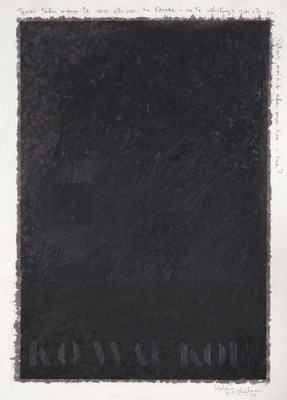B.
Drawing (KO WAI KOE?) by Ralph Hotere
Collection
This article first appeared in The Press on 28 March 2007
Among the highlights of the Christchurch Art Gallery's drawing collection is Drawing (KO WAI KOE?) by Otago artist Ralph Hotere. Produced in 1977 Drawing (KO WAI KOE?) illustrates Hotere's development from his formal geometric approach found in his earlier work of the late 1960s and early 1970s towards the more expressive manner he developed throughout the 1970s and 1980s.

Ralph Hotere Drawing (KO WAI KOE?) 1977. Lacquer, ink, pencil. Collection of Christchurch Art Gallery Te Puna o Waiwhetū, purchased 1978. Reproduced courtesy of Ralph Hotere
In Drawing (KO WAI KOE?) dense, colourful layers of lacquer have been freely applied like splattered raindrops, built up and absorbed into the body of the paper support. Over this field of lacquer a black rectangle of ink has been applied which subdues the expressive nature of the surface below yet allows subtle changes in tone throughout the composition. Hotere has worked over this dark mat background with pencil which provides a luminous silver sheen to the surface of the work. It is this element that brings the work within the definition of drawing in the traditional sense.
Text has been a prominent element in Hotere's work since the early 1960s and a poem by Hotere's father, Tangirau Hotere, is effectively incorporated into Drawing (KO WAI KOE?). Drawn in pencil, the stencilled Māori text ‘KO WAI KOE' melds with the abstract composition posing the question to the viewer - WHO ARE YOU? Cultural and self identity are central issues in much of Hotere's art and the inclusion of Māori text both within the composition and bordering the top right corner provides a context for the drawing.
Tenei taku manu te rere atu nei - he karere - no Te whitinga mai o te ra. Pataia mai - i ahu mai Koe i hea? KO WAI KOE? (This is my bird that flies to you - a messenger from where the sun rises - It asks from where have you come? WHO ARE YOU?)
Drawing (KO WAI KOE?) actively engages the viewer, enquiring into who we are and what makes us who we are. The past is an integral part of this and common to all is a unique ancestral heritage which plays an important roll, influencing who we are and where we have come from.
Drawing (KO WAI KOE?) was awarded first prize in the International of Drawings held in March and April of 1978 at the Robert McDougall Art Gallery. Organised by Christchurch printmaker Barry Cleavin it was the premier visual arts event for the 1978 Christchurch Arts Festival and included drawings by 193 artists from 35 countries.
Participation in the exhibition was by invitational letter with New Zealand art commentator Hamish Keith serving as the adjudicator. Among notable international entrants were Victor Pasmore, Joe Tilson, Kumi Sugai and Clinton Adams. Other New Zealand entrants alongside Hotere included Tony Fomison, Pat Hanly, Colin McCahon, Philip Trusttum and Toss Woollaston. The award afforded the Christchurch public the opportunity to view an extremely wide range of approaches to drawing and the catalogue accompanying the exhibition revels a huge variation in techniques and styles. The very notion of what constituted a drawing was freely interpreted by participating artists, many of whom did not confine their works merely to traditional graphic mediums such as pencil or charcoal. Many works expanded the traditional definitions of ‘drawing' with Cleavin stating at the time that the main criterion laid down was artistic excellence, not method. This is certainly the case with Hotere's Drawing (KO WAI KOE?) where the mediums of painting and drawing have been effectively united.
A member of the Aupouri tribe Hotere was born at Taikarawa in Northland in 1931 and initially studied art at the Dunedin Teachers' College in 1952. He received a New Zealand Art Societies Fellowship in 1961 which allowed him to study at the Central School of Art in London. He returned to New Zealand in 1965 and was awarded the prestigious Frances Hodgkins Fellowship at the University of Otago in 1969. He moved to Port Chalmers in 1972 where he continues to live and work.
Peter Vangioni









